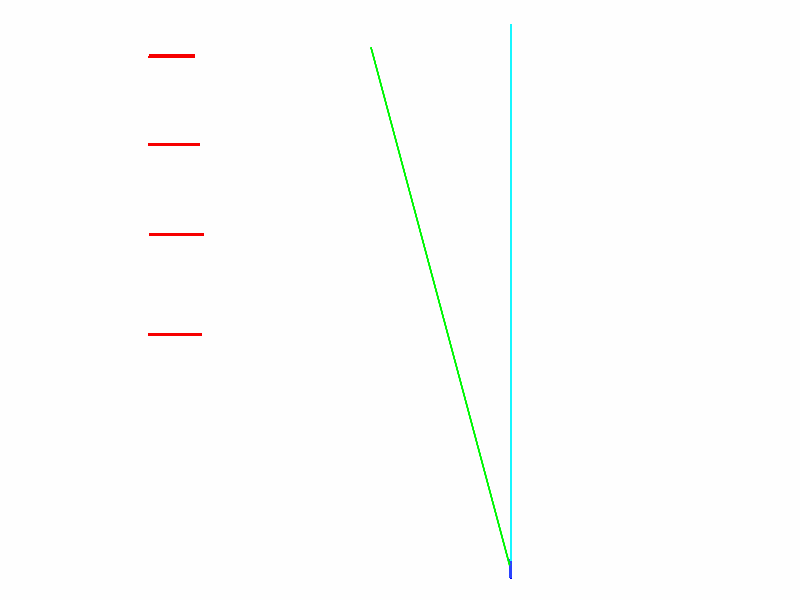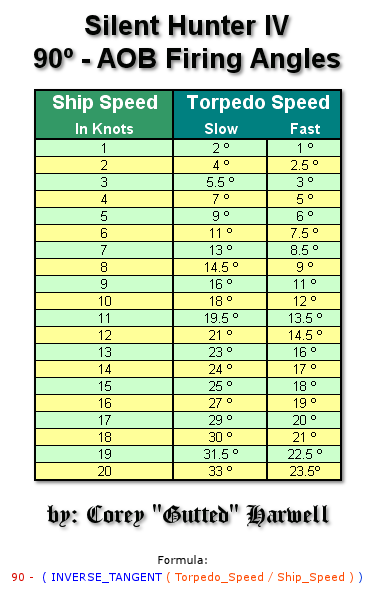
|
|
SUBSIM: The Web's #1 resource for all submarine & naval simulations since 1997
 |
SUBSIM: The Web's #1 resource for all submarine & naval simulations since 1997 |
|
|
 09-22-09, 07:34 AM
09-22-09, 07:34 AM
|
#1 |
|
The Old Man
 Join Date: Apr 2005
Location: New Orleans, LA.
Posts: 1,379
Downloads: 487
Uploads: 11
|
You could also just set yourself up at any abritrary angle to the target and not even use the TDC dials.
What you do is draw a straght line from your nose to where it crosses the targets path (you're trrue bearing). this is the impact point. then draw a line from the impact point down the targets course towards the target equal to his speed (5kts, draw a 500m.) note: could be yards doesn't matter. adjust your "course" line (the first one you drews) so that it's length is equal to your torpedo speed (46kts fast fish, 4600m). then measure the angle between those two end points. .ie click at the impact point, then click at the end of your torpedo line, then the end of the ships speed line. note the angle, then turn your periscope that many degrees from 0 towards the target and wait for him to cross it. doing this is quicker, and uses a zero gyro angle. which means you can hit any ship that crosses that line extremely accurately regardless of it's range. i hosed a target like this from over 7000m the other day. so there you go. you as captain should have a large bag of tricks. just try not to hemm yourself into 1 way of doing things. Using the PK to track a taret is still important IMO.. because if the target changes course at the last minute, you can fall back on it. Happened to me last night. Was approaching from the front parallel to his course... and had him squarely tracked with the PK. after i turned in for the shot when the range was short, the target made a course change.. turning towards my inside. crap! so i kept my turn going and selected the stern tubes. readjusted his AOB to what it looked like and grabbed a quick stadimter and fired. BOOM! Last edited by gutted; 09-22-09 at 07:54 AM. |

|

|
 09-22-09, 01:35 PM
09-22-09, 01:35 PM
|
#2 | |
|
Navy Seal
 |
Quote:
Gutted sent me a very simple animated gif that began all the madness, along with his lead angle chart he's talked about.   And there you see the genesis of the Dick O'Kane technique, posted and sent to me 8/19/2007 by gutted. At the time he was strictly a U-Boat jockey who had spent limited time in a fleet boat. He jumped into a thread where an upstart called Cali03boss was stinkin' it up and with one post started a revolution in Silent Hunter 4. (In the formula above, it should say arctangent instead of inverse_tangent, but there's the key to the universe, right there!  ) )
__________________
Sub Skipper's Bag of Tricks, Slightly Subnuclear Mk 14 & Cutie, Slightly Subnuclear Deck Gun, EZPlot 2.0, TMOPlot, TMOKeys, SH4CMS |
|

|

|
 09-22-09, 04:51 PM
09-22-09, 04:51 PM
|
#3 | |
|
Commodore
 Join Date: Nov 2004
Location: Right behind you!
Posts: 643
Downloads: 39
Uploads: 0
|
Quote:
Now I also wonder if he kept doing that after getting his own command or did he start going for 90 shots? |
|

|

|
 09-22-09, 06:45 PM
09-22-09, 06:45 PM
|
#4 |
|
Navy Seal
 |
I dunno. I think he took the shots as the situation dictated and wrested the odds as best he could. It's not like you look at an unfavorable position and say, "Nope. I don't like that angle."
Statistical analysis shows that a torpedo track angle of roughly 110º (varies with speed) is the most tolerant with regard to errors in calculating target speed. Reverse analysis of their mumbo-jumbo showed that firing at AoB 90 or slightly afterward was best for that. As far as maneuvering out of the way of the torpedo, a torpedo track angle of 90º would be the best because the target has to turn just as far in both directions to avoid. Let's reason this out. You're firing a John P Cromwell attack from 45º ahead. That ends up giving you an AoB of about 35º starboard or port depending on which direction he's coming from. The sharpest he has to turn to get his bow toward the torpedo and then be able to turn left or right to avoid is.....45º, right? OK, let's take the O'Kane situation. The torpedo approaches from 30º or more aft of the target beam (torpedo track angle of 120º or slightly more). We'll assume the target is moving left to right. Since the torpedo is approaching from aft, the speed of the target makes the approach speed of the torpedo slower, giving the target more time to react. Then the target needs only to turn 60º to port, hit the throttle and maneuver left or right to let the torpedo, now on a parallel course, pass starboard or port. I don't understand O'Kane's reasoning there. I'd rather be firing from ahead of the target if I can't pick the 90º attack, so that I have lots of wiggle room in my calculations and can absorb maximum error. Failing that I want the target to have minimum time to react if he sees the torpedo.
__________________
Sub Skipper's Bag of Tricks, Slightly Subnuclear Mk 14 & Cutie, Slightly Subnuclear Deck Gun, EZPlot 2.0, TMOPlot, TMOKeys, SH4CMS |

|

|
 09-22-09, 07:38 PM
09-22-09, 07:38 PM
|
#5 |
|
Seasoned Skipper
 Join Date: Apr 2005
Posts: 665
Downloads: 79
Uploads: 1
|
I wonder if there's some factors that we're leaving out. There are a lot of assumptions about a target maneuvering to get out of the way of a torpedo.
1. Target spots the torpedo equally well in all directions. 2. Target is able to ascertain torpedo motion well enough to make a fully reasoned maneuver. 3. Target decides what maneuver to make on a case-by-case basis instead of some rapid and wrote drills. 4. Likelihood of torpedo hit overrides all other tactical considerations like defensive posture. If all Japanese merchants were known to be trained to turn left when under a torpedo attack then that certainly changes your tactics. One might also regard that a target passing through AOB 90 gives the best chance to take good speed, course, etc data for an accurate shot which leaves the submarine aft of beam since the torpedo launch comes after the data taking. @RR: I'd like to see the same animated .gif with 1 torpedo passing through all 4 targets as if they had a hole in the middle of the ship. That picture is one way I like to attack convoys as several targets' solutions converge. I have found the AOB150 shots to be more error prone but then again I'm behind a desk and not in a leaky iron warboat 2000mi from home. As for Cromwell v OKane... they both give about the same leniency to the target to turn a short angle to negate the solution, apart from the time-to-impact difference. I think TTa 90 gives the most difficult evasion scenario for the target but I'm not 100% sure. Also ArcTan, Inverse Tangent, or Tan^-1 are all perfectly acceptable synonyms. I prefer the Tan^-1 notation when I can actually write the superscript proper unlike in forum posts. I kinda consider the "arc" prefix to be rather anachronistic and to be dropped from high school textbooks steadily. That chart has an error of either language or trig function. If you want to fire such that the torpedo tracks squarely into the target's side then that isn't a 90 AoB shot but a 90 TTa shot in which case ArcTan is correct. If you want to fire when the target is at 90 AoB (TTa > 90) then ArcSin is correct. |

|

|
 09-22-09, 08:38 PM
09-22-09, 08:38 PM
|
#6 |
|
The Old Man
 Join Date: Apr 2005
Location: New Orleans, LA.
Posts: 1,379
Downloads: 487
Uploads: 11
|
I called it 90AOB on my table due to the fact that in the U-baot (re: SH3) the periscope and aob dials were linked. so to take this kind of shot all one had to do was put the scope at 0 degrees.. set 90AOB (or any AOB for that matter), then train the scope left or right until the gyro read 0. thus taking a 90AOB shot. though techincally, it was less than 90AOB at the aim point becaues the AOB would change autommically with the scope in SH3.
this table was my attempt to simplify this for SHIV, since the two dials were not linked as in SH3. As for arctan, invtan.. im no mathemetician, but aren't they are the same thing. i put inverse tangent because the windows calulator doesn't have an arc tangent function. to get the same effect you do inverse tangent. .ie 1 / tan(x). to be honest, i dont remember why i have the "90 -" part of the formula there. This was done some years ago. Basically what i did was worked it out using the windows calculator.. then whipped up a quick C++ program to spit out the numbers, then dropped it into an XML file to print it. in windows calculator you'd do this for fast mk.14 vs 9 kt ship: 46 / 9 hit the = button hit the Tan button hit the 1/X again i cant remember what the "90 - " was for. anyway, i need to update that table one of these days. First off the table assumes Mk.14 torpedos (31kt slow, 46kt fast). and secondly i need to extend it off to the right for Impact AOB's other than 90, as i dont really try to set up for perfect 90AOB shots anymore now that i've grown found of the american TDC and find myself actually using it. .ie i dont line up perfectly at 90AOB and wait like a duck.. i'm always on the move manuevering now. though every now and then i find myself in a situation where i fall back on the table for hip shots. gives me a rough idea of how much i need to lead for a given target speed. Last edited by gutted; 09-22-09 at 08:56 PM. |

|

|
 09-22-09, 09:35 PM
09-22-09, 09:35 PM
|
#7 | |
|
The Old Man
 Join Date: Apr 2005
Location: New Orleans, LA.
Posts: 1,379
Downloads: 487
Uploads: 11
|
Quote:
you can call it whatever you want.. but im still calling it fast 90. *runs away screaming* |
|

|

|
 09-23-09, 03:11 AM
09-23-09, 03:11 AM
|
#8 |
|
Seasoned Skipper
 Join Date: Apr 2005
Posts: 665
Downloads: 79
Uploads: 1
|
|

|

|
 09-24-09, 04:24 PM
09-24-09, 04:24 PM
|
#9 |
|
Ocean Warrior
 Join Date: Sep 2008
Location: Notify command we have entered the Grass Sea
Posts: 2,822
Downloads: 813
Uploads: 0
|
Let's say the target is moving left to right at 5 kts. You draw a 500 yd. line on the target course to calculate the lead angle using the constant bearing method. Let's say the lead angle is 5 degrees.
If the target is not on that course, but closer of further away, running parallel, won't that change the lead angle? |

|

|
 09-22-09, 11:49 PM
09-22-09, 11:49 PM
|
#10 | ||
|
Commodore
 Join Date: Nov 2004
Location: Right behind you!
Posts: 643
Downloads: 39
Uploads: 0
|
Quote:
Quote:

|
||

|

|
 |
|
|
